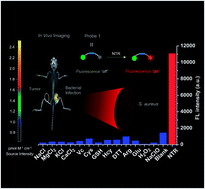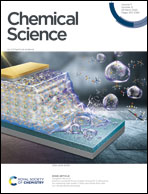Rapid differentiation between bacterial infections and cancer using a near-infrared fluorogenic probe†
Abstract
The reliable differentiation between bacterial infections and other pathologies is crucial for both diagnostics and therapeutic approaches. To accommodate such needs, we herein report the development of an activatable near-infrared fluorescent probe 1 that could be applied in the ultrafast, ultrasensitive and specific detection of nitroreductase (NTR) activity in bacterial pathogens both in vitro and in vivo. Upon reaction with NTR, the nitro-group of the para-nitro phenyl sulfonic moiety present in probe 1 was reduced to an amino-group, resulting in a near-infrared fluorescence turn-on of the latent cyanine 7 fluorophore. Probe 1 was capable of rapid and real-time quantitative detection of 0–150 ng mL−1 NTR with a limit of detection as low as 0.67 ng mL−1in vitro. In addition, probe 1 exhibited an outstanding performance of ultrafast measurements and suitable selectivity toward NTR to accurately sense intracellular basal NTR in ESKAPE bacterial pathogens. Most remarkably, probe 1 was capable of noninvasively identifying bacterial infection sites without showing any significantly increased signal of tumour sites in the same animal within 30 min.



 Please wait while we load your content...
Please wait while we load your content...